Displaying items by tag: Volvo Dun Laoghaire Regatta
#dlregatta – Lighter winds brought new leaders and relief to tired crews at Volvo Dun Laoghaire Regatta 2015 this afternoon. Two more races on the penultimate day have upset the pecking order in many of the 29–classes and set up tomorrow's final race as an appropriate climax to Ireland's biggest sailing event.
From a total fleet of 415-boats perhaps a half a dozen boats might rightfully be eyeing the overall boat of the week prize this evening but whoever is ultimately revealed as winner at tomorrow's National Yacht Club based prizegiving (Sunday at 3pm) the coveted trophy will be going to a crew that has managed to perform across the wind range.
In one of the most demanding series in the 12–year history of the event, superb Dublin Bay conditions have produced a season highlight to add heft to Dun Laoghaire's claim to be the 'Cowes of the Irish Sea'.
Moderate westerly winds produced flatter seas and gave some much needed relief to crews battered by the opening three races but the drop in pressure brought many changes to the scoresheets.
All classes will sail one more race tomorrow and in many cases the overall results will depend on this final race outcome.
One contender for tomorrow's (Sunday) top prize of the Volvo boat of the regatta trophy is the Farr 42 Wow, skippered by George Sisk, the Royal Irish yacht that now counts two wins from three races in a bumper turnout for the IRC offshore class.
A promising 10 to 12 knots westerly wind got racing for all 415 boats in 29 classes off to a solid start this morning and held all day to keep the ambitious programme of more than 200 races on target for tomorrow's final round.
The Sisk led 25-boat IRC offshore fleet departed Scotsman's Bay bound for South Burford, the first of eight turning marks on its 31–mile course.

The 31–mile IRC offshore course took four and a half hours to complete
The offshore fleet has one race left to sail tomorrow morning but already Irish Sea Offshore Racing Association (ISORA) Commodore Peter Ryan is hailing the offshore series within the regatta programme a 'terrific success'. 'Other regattas need to do what Dun Laoghaire has done and move with the times – offshore racing is here to stay', he said tonight.

The 25-boat IRC offshore fleet depart Scotsman's Bay bound for South Burford, the first of eight turning marks

The Cookson 50 Lee Overlay Partners (Adrian Lee) took line honours in Scotsman's Bay...

...George Sisk's Farr 42 Wow was second across the line to take the overall lead with one race left to sail tomorrow

Howth X302 Dux
Another contender for the top prize is the X302 Dux, the Anthony Gore–Grimes skippered Howth Yacht that has three wins from five races in IRC class three.
Dux mastered some of the trickiest conditions of the event so far to lead the 11–boat Volvo class three since racing began last Thursday.
A slip in race four ruined a perfect scoreline for Conor Phelan's Jump Juice crew but took another win in race five for the Royal Cork Yacht Club to have a seven point advantage at the top of the seven boat class zero.

Jump Juice has a commanding lead in class zero

Tony Fox's A35 Gringo leads class one

Rockabill V is lying third and Boomerang (to leeward) is ninth in class one
In class one, one Dublin Bay entry replaces another at the top of the leader board as Tony Fox's Gringo scored a race five win this afternoon to unseat 2014 national champion, Bon Exemple, an Xp33. Fox goes into the final race tomorrow with a single point cushion.
In class two, the South Caernarvonshire Yacht Club J97 Injenious continues to lead from Howth Half–Tonner Checkmate XV. Third is another modified Half–Tonner from Howth, Johnny Swan's Harmony.
The Royal Irish Quarter tonner Cri Cri has also produced a scoreline worthy of boat of the week consideration. Paul Colton counts three wins in the 16-boat fleet to lead Royal Ulster Yacht Club and Ballyholme entry Starflash (Alan Morrison and John Simms) by three points.

Storm leads Joker II by two points going into tomorrow's last race
In the J109 class, John Maybury's Joker II from the Royal Irish briefly overhauled Rush Sailing Club's Storm II for the first time in the series this afternoon but a final race win saw the north Dublin crew regain its two point margin. With one race left to sail both the Volvo and Irish title will be decided on the 'centre course' race track tomorrow morning.
In the one design divisions, three wins out of five races is good enough for Alan Harper's Leaky Roof 2 from the Clyde Cruising Club who leads Belfast lough rival Squawk (Paul Prentice) by two points.
With five wins from eight races Ian Mathews and Keith Poole have built a six point lead in the 20–boat Flying Fifteen class.
Olympic sailor Annalise Murphy together with her coach Rory Fitzpatrick are racing in the fast Moth class of the Volvo Dun Laoghaire regatta, the first time the foiling craft have raced in class in the biennial event. Fitzpatrick has eight wins from eight races. Murphy, sailing Bad Dolphin, is second in the eight boat fleet.

The overall prize giving will be staged at the National Yacht Club tomorrow at 3pm
All results subject to protest
Dun Laoghaire Regatta Day Two: Cruisers Racing, Dinghies & One Designs Postponed Due to High Winds
#dlregatta – Strong southerly winds have led to the postponement of some of the 29–racing classes at Volvo Dun Laoghaire Regatta this morning. All cruiser classes are racing but dinghies & one designs are postponed due to winds hitting 30 knots in gusts across Dublin Bay.
There was a dramatic start close to the Sandycove shoreline for the coastal class in Scotsman's Bay this morning for 25–competing boats. Local Farr 42, WOW, the Irish IRC Zero champion, that took an early lead yesterday was to the fore again as the fleet cleared Sandycove point led by the Cookson 50, Lee Overlay Partners.
Race officers are hoping for winds to moderate so all classes can race.
Biggs To Debut C&C30 at Dun Laoghaire Regatta
#dlregatta – Defending Volvo Dun Laoghaire Regatta (VDLR) 'Boat of the Week' Champion skipper Nigel Biggs returns to Dublin Bay next week for Ireland's biggest regatta. The Irish Times reports this morning on Biggs' new boat and an impressive debut at the Round the Island Race in Cowes last weekend.
UK–based Biggs hit a top speed of 18.3 knots downwind off the Isle of Wight, enough to put him 29th fastest monohull out of some 1800 competing on elapsed time in his new Mark Mills-designed American-built C & C 30 One Design. As Afloat reported previously, Biggs' new Checkmate XVI is the newest boat in the 415–boat Dun Laoghaire fleet. Read more in the Irish Times Sailing Column here.
#dlregatta – With the Kinsale ICRA Nats/Sovereigns Trophy 2015 very successfully concluded last weekend, and a classic Dun Laoghaire to Dingle Race put stylishly in place before that, the feeling of another sailing summer busily in progress is all-pervasive. But while the image projected may well be one of stately progress by the cruiser-racer fleets along the Irish coast, taking in an offshore race here and a regatta there with much leisurely cruising in between, the reality is usually otherwise. For those boats doing significant segments of the programme, it's a case of fitting chosen events into the usual hectic early summer life of work and family commitments and exams and everything else, with the re-location of boats to the next venue being a hurried task undertaken by delivery crews.
Next week sees the mid-season peak of the sailing summer, with the four day Volvo Dun Laoghaire Regatta 2015 in Dublin Bay from Thursday July 9th to Sunday July 12th. In a way it is an amalgamation of all that has has already occurred in this year's season, together with new elements to make it a unique sailfest which celebrates the fact that the citizens of Ireland's capital city and their guests can be conveniently sailing and racing within a very short distance of the heart of town. W M Nixon sets the scene
In the dozen or so years since its inception, the biennial Volvo Dun Laoghaire Regatta has settled itself firmly into the sailing scene as an exceptionally varied event in terms of the boats and classes taking part. There are five regular cruiser-racer classes, plus an offshore division, fourteen one design keelboat classes, and nine dinghy classes. And although there are contenders from Ireland's north coast and from the Cork area and south coast too, together with one gallant entry from Galway, it is essentially an Irish Sea Sailfest, though with a remarkably strong Scottish presence.
However, it was on the coast of Wales at 8.0pm last night that this sailing celebration began, with an ISORA Race starting in Holyhead and heading for Dun Laoghaire to set this large and complex programme into action towards a culmination on Dublin Bay in eight days time with the conclusion of VDLR2015.
2015 marks the Bicentennial of the Royal Dee YC, which was founded in 1815 on the Cheshire shores of the River Dee estuary where northwest England marches with northeast Wales. Originally the Dee Yacht Club (and founded, it's said, a month or two before the Royal Yacht Squadron came into being in the south of England, making the RDYC the second-oldest Royal yacht club in England after the Royal Thames), the Cheshire club became the Royal Dee YC in 1847.
Although the great prosperity of Liverpool in the 19th century saw the club's fleet of substantial yachts gathered in the Dee and then increasingly in the Mersey, by the late 1900s it was looking to the Menai Straits area as the focus of its keelboat events. As well, the completion of Holyhead breakwater in 1873 added a new and important harbour to its list of possible big boat sailing locations, and there was an increase in the number of cross-channel "matches" which the Royal Dee and the Royal Mersey, in conjunction with the Dublin Bay clubs, had already been running for some years.

A Royal Alfred YC cross-channel match from Dublin Bay to Holyhead gets under way in 1888. Cross-channel links were strong in the latter half of the 19th Century, and with the new breakwater completed at Holyhead in 1873, a new venue was available both for the Irish clubs and those on the other side such as the Royal Dee and the Royal Mersey

The bicentenary logo of the Royal Dee YC. In 1815, this club on the Cheshire coast was founded shortly before the Royal Yacht Squadron in the souh of England, whose Bicentennial is being celebrated at the end of July.

Dun Laoghaire saw its first regatta staged in 1828, and participation by yachts from the northwest of England and North Wales was regularly recorded. This is the Royal St George YC regatta of 1871.
So when we say that the Royal Dee has always been a stalwart of offshore racing in the Irish Sea, we're not referring to a story spanning only the 20th and 21st Centuries. On the contrary, it goes well back into the 1800s. And now, with the revival of keelboat sailing in the Mersey with several of Liverpool's myriad docks being given over to recreational use, we have in a sense come full circle with enthusiastic Dublin Bay support of the Bicentennial celebrations reflecting sailing links which go back almost 200 years
The Lyver Trophy is the Royal Dee's premier offshore challenge, and this year it is special, as it's a fully-accredited RORC event counting for points in the annual championship, and a highlight of the ISORA Programme 2015. It's start scheduled for yesterday evening in Holyhead will see the fleet – mostly regular ISORA contenders – sail a course of at least a hundred miles before finishing in Dun Laoghaire. Then as VDLR 2015 gets under way, races in it, combined with the Lyver Trophy results, will count as part of a series towards finding an overall winner of the RDYC Bicentennial Trophy.
Only entrants in the Lyver Trophy race are eligible, and for that race itself – which can be followed on the Averycrest Yellowbrick Tracker - the favourite has to be the Shanahan family's J/109 Ruth, still buoyed up by her great victory in the Dun Laoghaire to Dingle Race three weeks ago.

Back in The Bay – the Shanahan family's J/109 Ruth will be back in her home waters of Dublin Bay after winning the Dun Laoghaire to Dingle Race and completing the Lyver Trophy Race from Holyhead which started last night. Photo: David O'Brien
At the other end of the size scale, the VDLR2015 Dublin Bay programme includes several dinghy classes, and the biggest fleet will be mustered by the International GP 14s, who have designated the racing in Dublin Bay as their Leinster Championship. In an interview with Sailing on Saturday in March, VDLR Chairman Tim Goodbody emphasised that, overall, the event should be seen as a regatta rather than a championship, and for most boats that's just what it will be. But the GP 14s with their great esprit de corps have always done things their own way, and with their compact boat size – albeit comprising a large fleet of dinghies – they reckon they can get in a proper championship while sharing in the fun of the event.
 The brothers John and Donal McGuinness of Moville Sailing Club in Donegal are expected to be among the pace-setters in the GP 14 class with their superb Alistair Duffin-built boat. Photo: W M Nixon
The brothers John and Donal McGuinness of Moville Sailing Club in Donegal are expected to be among the pace-setters in the GP 14 class with their superb Alistair Duffin-built boat. Photo: W M Nixon

The GP 14 Ulsters 2015 were recently won on Lough Erne by Shane MacCarthy & Damian Bracken of Greystones
As to who is favourite, the McGuinness brothers – Donal and John - from Moville in Donegal, with their top-of-the-line Duffin boat built in Northern Ireland, have to be in the reckoning after being top Irish at last year's Worlds on Strangford Lough, but there's fresh blood in the fleet with the newest class developing at Youghal, while this year's recent Ulster Championship on Lough Erne was won by the Greystones duo of Shane MacCarthy and Damian Bracken.
The dozen and more boats coming south from Scotland, most of them substantial cruiser-racers, are testimony to a growing trend in sailing on Europe's Atlantic seaboard. Given a choice of venues, your average yachtie on this long coastline will incline to head south if at all possible. Other things being equal, it's reckoned the further south you go the warmer it is likely to be. And from the upper reaches of the Firth of Clyde, there are times when Dublin Bay might seem like the distant and sunny Mediterranean.
Maybe so, but we'd caution that much depends on the moods and location of that all-powerful weather determinant, the northern Polar Jetstream. In July, so long as it's well clear of Ireland -whether to the north or the south - we will have glorious high summer, and that occurred for the previous VDLR back in 2013, where the photos speak for themselves.
So we hope for the best in looking forward to welcoming a fleet of around 415 boats to Dun Laoghaire between July 9th and 12th, with all four of our in-harbour yacht clubs extending the hand of hospitality in a regatta tradition that goes right back to 1828. But while heritage and ceremonial are all very well in their place, it's the prospect of good sport which energises the participants and their sailing, and with several major contests already logged in 2015, what can we expect on the leaderboards next week?
At the top of the tree, Class 0 has formidable competition, including former Scottish champion Jonathan Anderson racing his XP38i Roxstar against the Royal Cork's Conor Phelan with the Ker 37 Jump Juice, which was one of the best performers in last year's ICRA Nationals at the same venue, and this year again became a force to be reckoned with as the breeze sharpened in the four day Kinsale ICRA Nats 2015/Sovereigns Cup a week ago.
 Freshly squeezed – her storming finish to last weekend's final race of the ICRA Nats/Sovereigns Cup at Kinsale makes Conor Phelan's Ker 37 Jump Juice one of the top contenders in the VDLR2015. Photo: David O'Brien
Freshly squeezed – her storming finish to last weekend's final race of the ICRA Nats/Sovereigns Cup at Kinsale makes Conor Phelan's Ker 37 Jump Juice one of the top contenders in the VDLR2015. Photo: David O'Brien
With a win in the final race, Jump Juice came in second to seasoned campaigner George Sisk's class overall winning Farr 42 WOW (RIYC), the pair of them in turn displacing the early leader, lightweight flyer Mills 36 Crazy Horse (ICRA Commodore Nobby Reilly & Alan Chambers, HYC) down to third in the final day's racing, so Crazy Horse will be hoping for a return of lighter breezes when racing starts next Thursday on Dublin Bay.
In the previous Volvo Dun Laoghaire Regatta in 2013, the most successful boat in was Nigel Biggs' much-modified Humphreys Half Tonner Checkmate XV, but this year the Biggs team is racing as Checkmate Sailing with the newest boat in the fleet, the Mark Mills-designed American-built C & C 30 OD Checkmate XVI. She may be only 30ft LOA, but she's such a hot piece of work with so many go-fast bells and whistles that she has a rating of 1.140 to put her in Class 0.
The oldest boat in the cruiser-racer fleets will be found in Class 3, where the 44ft Huff of Arklow is making an historic return to Dublin Bay racing. Originally built in 1951 by Jack Tyrrell of Arklow to a design by dinghy genius Uffa Fox, Huff is so-called because her concept is reckoned three-quarters Uffa Fox and one quarter Douglas Heard. The latter was the founding President of the Irish Dinghy Racing Association in 1946, and he later went onto to become Commodore of the Royal St George YC and a noted cruising and offshore racing enthusiast with this unusual boat, which is like a very enlarged Fying Fifteen with a lid – in fact, with her 30ft-plus waterline, she was described as a Flying Thirty. In recent years she has undergone a total restoration with Cremyll Keelboats near Plymouth in Devon, and Dominic Bridgeman of the Cremyll group will be racing her with trainee crews in her old home waters of Dublin Bay.

The Flying Thirty Huff of Arklow racing off Dublin Bay while under Douglas Heard's ownership in the 1950s. Built by Tyrrell's of Arklow in 1951, the hugely innovative Huff has recently had a major restoration, and will be making her return to Dublin Bay to take part in VDLR2015.
Among the newer boats on the bay, the 2013 champion Checkmate XV is still very much in the picture, but now she's owned by Howth's Dave Cullen, and took second overall in class in the Kinsale series a week ago. In Dun Laoghaire next week, she's with other Half Tonners at the lower end of the Class 2 rating band on 0.944, almost 200 rating points below the new Biggs boat. Class 2 also includes the Division 3 winner at Kinsale, Richard Colwell & Ronan Cobbe's Corby 25 Fusion (HYC) which bested VDLR 205 Chairman's Sigma 33 White Mischief in a real duel after they went into the final day's racing equal on points, while another Kinsale success story in the Class 2 lineup is Paddy Kyne's X302 Maximus from Howth, overall winner of the Portcullis Trophy for top ECHO boat.

Dave Cullen's modified Half Tonner Checkmate XV will be looking to take the top slot on Dublin Bay after being runner-up in Kinsale. Photo: David O'Brien
In between the two Checkmates on ratings, we find most of the cruiser-racer fleet, with Class 1 shaping up some interesting competition between the likes of Paul O'Higgins Corby 33 Rockabill (RIYC), Kenneth Rumball skippering the Irish National Sailing School's Reflex 38 Lynx, and two very sharp First 35s, Prima Luce (Burke, Lemass & Flynn, NYC & RIYC) and another former Scottish Series champion, John Corson (Clyde Cr C) with Salamander XXI.
This year's Scottish Series Champion and the Afloat.ie "Sailor of the Month" for May, Rob McConnell of Dunmore East, will certainly be racing in the VDLR 2015, but whether or not it's with his all-conquering A35 Fool's Gold (second in class at Kinsale) or aboard another boat (a Flying Fifteen) remains to be seen. And the Top Sailor Count doesn't end there, as there'll be at least four Olympic sailors involved in four different classes, with Robin Hennessy racing in what has all the marks of a quality International Dragon fleet against the likes of former Edinburgh Cup winner Martin Byrne, Annalise Murphy racing in the Moths which will surely be a change from the Water Wag which she raced with her mother Cathy MacAleavy (also another ex-Olympian) last time round, and Mark Mansfield helming John Maybury's J/109 Joker 2. After Joker 2's class overall win in Kinsale, we can expect a battle royal in the J/109s with boats of the calibre of Ruth for the National title fight.

The Shipman 28s find that the sport and socializing which the VDLR guarantees will provide some of their best racing of the year. Photo: VDLR
The J/109s are the queens of an impressive array of One Design keelboats which includes Sigma 33s (where VDLR 2015 Chairman Tim Goodbody's White Mischief is racing under the command of Paul McCarthy), Beneteau First 31.7s, Shipman 28s having one of their best gatherings of the year, Ruffian 23s with a good turnout, the attractive First 21s which are steadily gaining traction as a Dublin Bay class, and best OD keelboat turnout of all is by the Flying Fifteens, nearly all of them under the NYC flag.

Olympians all – in VDLR2013, Olympic sailors Cathy MacAleavey (1988) and her daughter Annalise Murphy (2012) raced the family Water Wag Mollie. But while Cathy will be sailing Mollie again this year, Annalise will be on her own racing a foiling International Moth.

Newest of the oldest – Adam Winkelmann and Doug Smith's new French built Water Wag No.46, Madameoiselle, has been launched in time for the regatta. Photo: Owen McNally

The Howth 17s of 1898 vintage will be the oldest class racing. Photo: David Branigan
Veteran classes include the IDRA 14s from 1946, the Glens from 1945, the Howth 17s of 1898 which pre-date the 1902 Water Wags, and the 1932 Mermaids, the latter being in the interesting position of no longer having an official division in Dun Laoghaire, yet it's a Dun Laoghaire skipper, Jonathan O'Rourke of the National, who continues to dominate the class both at home and away.
With large fleet numbers afloat guaranteed, the shoreside programme is appropriately busy, with the official side of each day's racing concluded by the evening's daily prize-giving at one of the four waterfront clubs. But with so many sailors involved, there'll be action in all the clubs – and at other establishments in Dun Laoghaire - throughout the week. The scene is set, let the party begin at a venue which has been staging regattas since 1828.
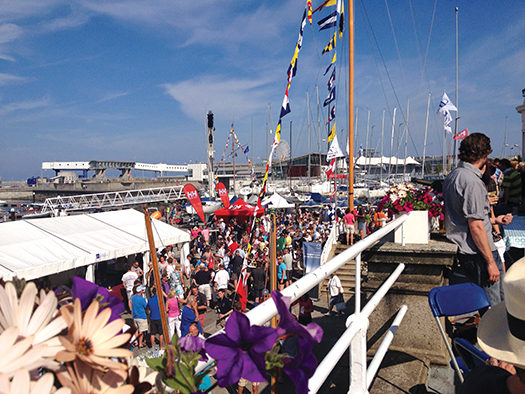
When the summer comes, the après sailing at the VDLR is world class. Photo: VDLR
Further reading:
Download the full entry list for Dun Laoghaire Regatta 2015 class by class below
Download the Sailing Instrcutions for Dun Laoghaire Regatta 2015 HERE
- Dun Laoghaire Regatta
- Volvo Dun Laoghaire Regatta
- Royal St George Yacht Club
- Royal Irish Yacht Club
- National Yacht Club
- ISORA
- Water Wags
- Royal Alfred Yacht Club
- yellowbrick
- GP 14
- Nigel Biggs
- George Sisk
- Annalise Murphy
- Half Tonners
- Tim Goodbody
- Mermaid
- Fool's Gold
- Dragon
- Irish National Sailing School
- Kenneth Rumball
- Dublin Bay
#dlregatta – The Sigma 33 class has announced its Irish National Championships 2015 will be held in conjunction with Volvo Dun Laoghaire Regatta from 9th to 12th July 2015. The regatta is likely to be the biggest Sigma Class event of 2015, accordiong to class captain Paddy Maguire. 'To date there is a very strong entry of seven visiting crews which with the local fleet brings the total entry so far to 16', he told Afloat.ie. This – to date – is the biggest entry of one design cruisers for the 400–boat biennial regatta.
UK Visitors Swell Dun Laoghaire Regatta Entries – Fleet Size to Reach 400 Boats By July
#dlregatta – As tonight's Dublin Bay Sailing Club summer season gets underway, Ireland's biggest sailing event at the same venue, Volvo Dun Laoghaire Regatta, is preparing to welcome some potent visitors to the Bay in July as its massive fleet is now expected to hit the 400 mark.
UK visitors are swelling the ranks of some 28 classes; IRC Cruisers, One Design Keelboats and Dinghies with 40% of the current entry coming as visiting sailors from overseas.
As well as Nigel Bigg's new C&C 30 design, there's a strong fleet of Beneteau and Corby designs making the trip across the Irish Sea. Kevin Aitken's Animal (Beneteau First 36.7) from the Clyde Cruising Club will be joined by Helensburgh sistership Carmen 2 (Paul Scutt and Alan Jeffrey). Liverpool Yacht Club is sending Jim Cartwright's Beneteau Daydream Believer and Kenneth Roberts Ker 36. Another Clyde visitor is the Sigma 38, Engima skippered by Howard Morrisson. Welsh yacht Impostor, a Corby 33 from South Caernarvonshire Yacht Club, will be skippered by Richard Fildes. Swansea is sending the Dubois 37, Dark Angel.
A record 68 clubs are currently represented with many of the 2013 class champions returning.
In 2009, the Irish Marine Federation (IMF) launched a case study on the socio-economic significance of the regatta. Six years ago, the biennial event attracted an entry of 449 entries. Over four days, the study (carried out by Irish Sea Marine Leisure Knowledge Network) found the event was worth nearly three million to the local economy.
For the latest updates on Volvo Dun Laoghaire Regatta 2015 click this handy link
Read also WMN Nixon's recent Afloat.ie blog: Dun Laoghaire Regatta Promises Champion Quality Yacht Racing For All
#dlregatta – In a first for Dun Laoghaire Regatta the first C&C30 design in Europe will compete for the overall title at Ireland's biggest regatta this July.
After dominating their class and being crowned top overall boat at the 2013 Dun Laoghaire Regatta, Checkmate Sailing from the Royal Irish Yacht Club are returning to Dublin Bay to defend the title. Their all conquering Humphreys Half Tonner has been replaced with Checkmate XVI, a new C&C30 from the drawing board of Wicklow based designer Mark Mills.
Skipper Nigel Biggs says "Dun Laoghaire Regatta has always been one of our favourite regattas. We have competed here for many years and having been honoured with the top boat award last time, we were determined to come back and try to retain this prestigious award.
During our last project with Checkmate XV we were fortunate to work with Mark Mills who was instrumental in turning a near 30–year–old IOR racer into a competitive IRC boat. Having sold Checkmate XV to our good friend Dave Cullen we were looking for a successor and Mark suggested the new C&C 30 that he had designed.
The boat ticked every box for us, sailed by a relatively small crew, extremely fast, trailable and with the prospect of competitive one-design racing. Checkmate XVI is the first of the class in Europe and although she has only recently arrived from the US we are already finding her extremely rewarding to sail. We are very much looking forward to bringing her to Dun Laoghaire Regatta and catching up with all our friends again
Biggs says 'we have always been made to feel incredibly welcome at this event and feel it strikes the perfect balance between competitive racing and fun socialising. I am extremely privileged to have recently been elected as a member of the Royal Irish Yacht Club and am looking forward to racing under their burgee this year'.
The C&C 30 One Design and offshore-capability and fast sailing performance at an affordable price has picked up the 2015 American SAIL MAGAZINE Best Boat award. See vid below.
{youtube}Vb2na2iwvn8{/youtube}
Promoter C&C in the USA hopes to develop the boat into a high-performance, offshore-capable one-design class that's both easy to sail and affordable compared to other grand prix boats.
The C&C 30 is loaded with go-fast goodies including a centerline sprit pole, a double-spreader carbon-fiber rig, an open transom, an offset companionway, a flush deck, plumb bow, halyard locks (main and jib) and an expansive cockpit.
The C&C 30 is being built in Bristol, Rhode Island.
#cruiserracing – Can you successfully incorporate a full-blown National Championship into an established neighbourhood regatta? We're going to find out from June 24th to 27th, when the ICRA Nationals and the Sovereigns Cup in Kinsale are combined into one four day event, the result of the joint efforts of two sets of organisers and administrators. W M Nixon takes a look at how this situation has developed and discovers four of the top men in the marine and sailing scene have significantly different views as to how big regattas and the ICRA Nationals should be staged.
The Irish Cruiser-Racer Association emerged from an attitude of complete realism about the contemporary sailing scene in 2002. Back then, the Irish economy was starting to develop a head of steam, and people were buying potent performance-cruisers which just begged to be raced offshore. Yet changing social attitudes meant that the traditional concept of an offshore racing crew being prepared to spend seven or eight long weekends away every summer campaigning the boat in classic offshore races simply wasn't acceptable in the new world of shared family responsibilities.
But the short-lived ideal of making classic offshore racing more family-friendly was also soon seen as unattainable except for those few extra special family crews – we can all think of one or two examples - whose very uniqueness in their shared enthusiasm for rugged offshore sailing day and night only serves to emphasise that what they like doing is simply not for the majority of sailing families.
For sure, we admire them without reservation. But we know that it won't float our family's boat. For although the totality of Irish "cruiser-racers" in 2002 included several out-and-out racing machines which were vigorously campaigned inshore and offshore, the reality is that most of the fleet were the sailing equivalent of those 4x4 SUVs which block up the parking in many a leafy and affluent suburb.
Usually, the most adventurous outing such vehicles will go on is the daily school run. There's no way their loving owners plan an aggressive demonstration of their pride-and-joys supposed off-road ability. But they do seem to find it reassuring to know that if for some reason they suddenly have to go across rough terrain, the vehicle can manage it even if the driver is scared stiff. And of course, in the unlikely event that a horse-box needs to be towed – well, no problem......
So, thirteen years ago as sailing's equivalent of the SUV began to take over marinas, two leading figures in sailing administration realised that, far from changing the new increasingly family-oriented way of doing things and forcing boats well capable of going offshore to do so even if their crews didn't particularly want to, what was needed instead was a new kind of event to suit the way that most people wanted to sail with their new performance cruisers.
The late Jim Donegan of Cork, Commodore of the South Coast Offshore Racing Association, was ocean racing aristocracy – his grandfather Harry owner-skippered the 18-ton cutter Gull to third place overall in the first Fastnet Race in 1925, and consequently became one of the founder members of the Ocean Racing Club which six years later in 1931 became the RORC, while Jim himself was to go on to win many an offshore contest.
Fintan Cairns of Dun Laoghaire has given generously of his energy and time over the years to sailing both as an active participant, a race officer, and an administrator – he was Commodore of Dublin Bay Sailing Club at a period of its healthiest expansion. Like Jim Donegan, in 2002 he was hugely enthusiastic about racing boats with lids, and he loved the offshore game. Yet in the Autumn of 2002, the two of them convened a national assembly in Kilkenny in order to form an organization whose primary aim would be to create the kind of event that would be attractive to the new generation of cruiser-racer owners, people whose boats could go offshore, but preferred the nice regatta atmosphere and home-to-port-at-the-end-of-the-day format.
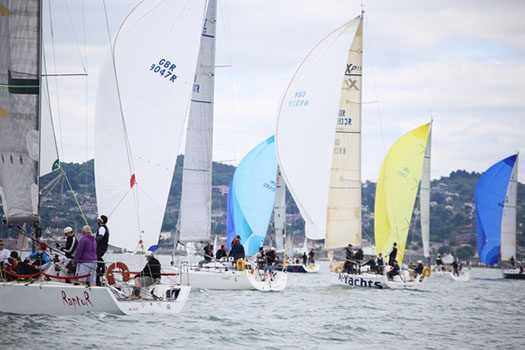
A nice regatta atmosphere, and back to port at the end of the day.....the racing in the ICRA Nationals 2014 at the Royal Irish YC in Dun Laoghaire neatly captures the purpose of the organisation as envisaged by the founders in 2002. Photo: David O'Brien
Thirty-one years earlier in 1971, the Irish Sea Offshore Racing Association had been formed by enthusiasts like Hal Sisk of Dun Laoghaire and Dickie Richardson of Holyhead on the assumption that their new organisation should be related to an area of good and extensive racing water, and for a while it worked very well. At its peak, ISORA was attracting a total entry of 107 different boats from all arts and parts into their annual season-long championship in which – if you were intending to be a serious contender – you had to think of racing at least seven events.
That meant seven weekends which, in some cases, inevitably meant leaving your home port on the Thursday and maybe not getting back until Monday morning or even later. Fine and dandy in its day, but its day didn't last too long. Maybe fifteen years in all. By then, new attitudes to family life and a tendency to concentrate one's sailing on a few big events combined with other less time-consuming smaller local events, meant that the ISORA model was no longer valid.
Yet boat numbers in ports kept increasing, so the Irish Cruiser Racing Association came into being at that November meeting in Kilkenny in 2002 to provide Irish-based regattas which, in some cases, would involve trailing the smaller boats to distant venues still on the island of Ireland, instead of sailing them many miles to others ports across the channel.
For old salts, the idea of an offshore racing association based on a land mass, and the notion of road-trailing offshore racers across that land mass to a regatta, seemed absurd. But this was only the beginning of it. For unless there was an unexpected demand for it, the new ICRA programme had no plans to include any overnight sailing except where it involved the training up an Irish Commodore's Cup team, as this was soon within ICRA's ambit.
Basically, what it meant was that ICRA's purpose was to organize an annual national championship regatta of four days at one of Ireland's main sailing centres, chosen on a rotational basis, they would also honour a "Boat of the Year", and every second year they would assemble a Commodore's Cup team.
Far from owners being faced, as they were in the old days, with the challenging demands of preparing a boat for offshore racing and then assembling an experienced crew from a panel in which the ideal number would be twice the number required to crew the boat, instead they were now offered an agreeable pattern of day sailing at some pleasant venue, and much socialising with it, while the results were efficiently calculated by ICRA's travelling road show of race administrators and number crunchers.
Yet for anyone who thought this wasn't really quite rugged enough, there was ruggedness-by-association with the Commodore's Cup campaigns. And all this went particularly well as the Irish economy went stratospheric from 2002 until 2008, so much so that at one stage Ireland actually fielded three different Commodore's Cup teams which even had the luxury of competing against each other. There's posh for you......
But it was too good to last, and ironically the economy had already fallen off a cliff in 2010 when a very serious single team Irish Commodore's Cup campaign, carefully led by Anthony O'Leary, finally won the Commodore's Cup. Also during 2010, the ICRA Nationals in late May were hosted by the Royal St George YC in Dublin Bay, which provided immediate access to the largest fleet of cruiser-racers in Ireland. Thus numbers were easily kept up to a respectable level and in all – the brutal recession notwithstanding – it was a great year for ICRA, with the 2010 Commodore Barry Rose, who had also been the Commodore's Cup Team Manager, deservedly accepting the Mitsubishi Motors "Irish Sailing Club of the Year" award after this great season.
But inevitably, things were more subdued for the next three years as the longterm ill-effects of the recession took hold. So though ICRA Nats were held in Crosshaven in 2011, Howth in 2012, and Fenit on Tralee Bay in 2013, resources were so scarce that the decision was taken not to attempt a defence of the Commodore's Cup in 2012.
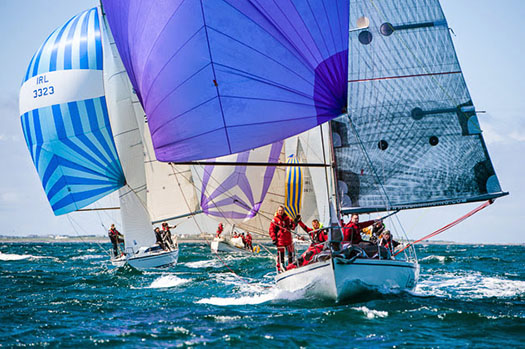
The images which came back from the ICRA Nationals 2013 in Tralee Bay suggested good sailing, but for two days the stormy weather caused a complete shut-down. Photo: Bob Bateman
When one cornerstone is removed, others are examined in more detail. The 2013 ICRA Nationals in Tralee Bay had the misfortune to coincide with a period of very unsettled weather which emphasised the fact that many of the top boats had travelled a long way by both sea and land to this gallant outpost of the Irish offshore racing scene to link up with their WIORA counterparts. But although some spectacularly sunny photos of racing in strong winds and bright sunshine emerged, the reality is that they barely had two days of viable competition as the rest of the programme was blown out in utterly miserable storm conditions.
Coming as it did at a time when the economy was barely faltering back into life, this unlucky outcome led to it being open season for suggestions as to the way ahead. There were those who wondered if people's seemingly ever-decreasing sailing time might be better used if the ICRA Nationals were combined into some established events, pointing out that a natural annual rhythm was already there with the biennial Volvo Cork Week rotating with the biennial Volvo Dun Laoghaire Regatta to provide easy access for large local fleets.
When set against the all-Ireland idealism of the founders, this was anathema to many, as the stand-alone national event, with the effort made to go anywhere in Ireland where you could find substantial local cruiser-racer fleets, was seen by some as central to the ICRA ethos.
However, things were put on hold during 2014 with a well-supported if locally-emphasised ICRA Nationals hosted by the Royal Irish YC in Dublin Bay in June, and then in July there was a mighty victory in the Commodore's Cup 2014 in a wonderful effort built around quiet background work by team captain Anthony O'Leary.

ICRA Nats 2014 in Dublin Bay saw a popular win in Class 0 for the Phelan family's Ker 36 Jump Juice from Crosshaven. Photo: David O'Brien
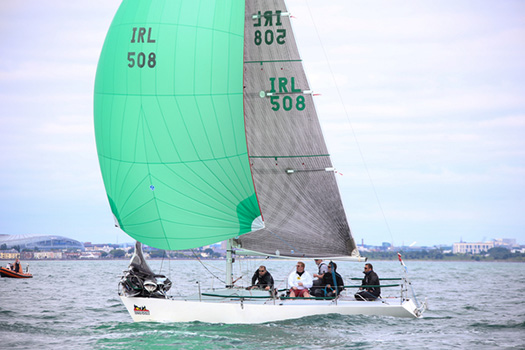
Jonathan Skerritt's vintage Quarter Tonner Quest of the host club was overall winner of the ICRA Nats 2014 at the RIYC. Photo: David O'Brien
But meanwhile, faced with the reality of the recession in sailing, ICRA's senior number cruncher Denis Kiely had quietly been putting out feelers about the possibility of combining the 2015 ICRA Nationals with Kinsale YC's biennial Sovereigns Cup regatta, which has been trundling along since 1995. By the time the great 2014 season was fully under way, it was no secret that this arrangement for 2015 was already in place, thereby guaranteeing – it was hoped – a substantial increase in numbers in 2015 and better overall value for the sailing community, while at the same time taking the ICRA Nationals to another new venue.

The perfect sailing in the 2013 Sovereign's Cup at Kinsale inspired ICRA officers to seek the link-up for the ICRA Nationals 2015 with the Sovereigns Cup 2015. Photo: Bob Bateman
At first glance, it seemed eminently sensible. But not everyone agreed. It was towards the end of an engaging interview with Commodore's Cup winner Anthony O'Leary at the end of July last summer in his beloved Royal Cork YC, just four days after he and his team had received the trophy on behalf of Ireland on the Royal Yacht Squadron lawns in Cowes, that I witnessed the first significant shot going across the bows of the good ship ICRA/Sovereigns of Kinsale.
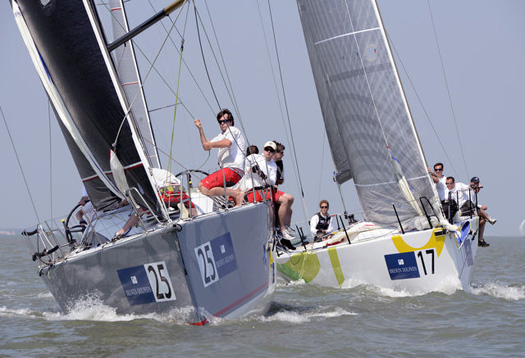
Team Captain Anthony O'Leary's veteran Ker 39 Antix hanging in there to stay ahead of a newer Ker 40 to lead Ireland to victory in the 2014 Commodore's Cup. Photo: Rick Tomlinson
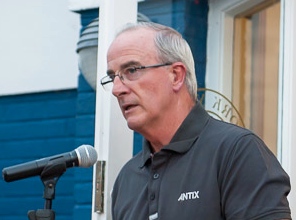
Someone whose considered opinion has to be taken seriously – Anthony O'Leary in thoughtful mood as he speaks at a reception to welcome the Commodore's Cup back to the Royal Cork YC. Photo: Bob Bateman
Anthony O'Leary was quite clear in his mind as to how the Irish cruiser-racing scene should go forward. And just as you should never get into a row with people who buy ink by the barrel, equally you wouldn't dream of openly disagreeing with someone who has just pulled Irish sailing out of the doldrums, so I just sat still and let this broadside roll over me.
"I think it's a mistake to incorporate the ICRA Nationals in the Sovereigns Cup in Kinsale....." he said bluntly. "The Sovereigns is one of my favourite regattas, but it's a friendly intimate business. While the town may have the infrastructure ashore, the marina is always crowded and I don't see how the kind of fleet they hope to attract will be comfortably accommodated there".
"Then too" he continued, "we already have two major alternating four day regattas in Dun Laoghaire and Cork Harbour. It's time to accept that sailing people are seeking to focus on fewer major events, and to give a more compact annual programme their best shot. So let's see how it would work if the ICRA Nationals simply rotated between Volvo Cork Week and the Volvo Dun Laoghaire Regatta".
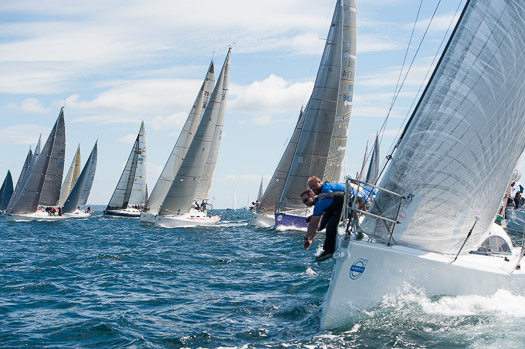
Clean close racing at Volvo Cork Week 2014. There's a line of thought that reckons this regatta could comfortably incorporate the ICRA Nationals. Photo: Bob Bateman
You can see how, in the circumstances, this idea seemed vibrant and immediately attractive. But more recently in an interview with another equally renowned sailor, Tim Goodbody who is Chairman of the Volvo Dun Laoghaire Regatta Committee 2015 there was something said which gave further pause for thought.
Tim Goodbody was totally clear in his own mind about the thinking behind the successful VDLR concept and its ability to provide viable racing for 31 different classes, and as he has helmed to victory both inshore and offshore to the highest levels, while also proving himself a master at designing courses for Dublin Bay, his views carry every bit as much weight as those of Anthony O'Leary.
"You have to remember it's a regatta, not a championship" said Goodbody. "Enjoyment of sport comes first, and the purity of fierce competition second. But of course we're going to provide the best possible starts. And the intention is to have those starts leading into the best possible courses in the conditions prevailing"
"Yet the way we see it, people should be racing just as soon as possible after leaving the harbour. There's nothing which impairs simple sailing enjoyment so much as having to wait around in a perfectly good but maybe fickle sailing breeze, hanging about in frustration while an overly-pernickety Race Officer dithers over setting the absolutely perfect start line".
In the context of the fun-filled suburban sailfest which is the VDLR, that's a perfectly reasonable approach. But is it a proper approach for something which aspires to call itself a National Championship? I rather doubt it, and there's no way the VDLR claims to be a national championship even if the numerous GP 14 Class are calling their enthusiastic participation in the VDLR 2015 the class's "Leinster Championship".
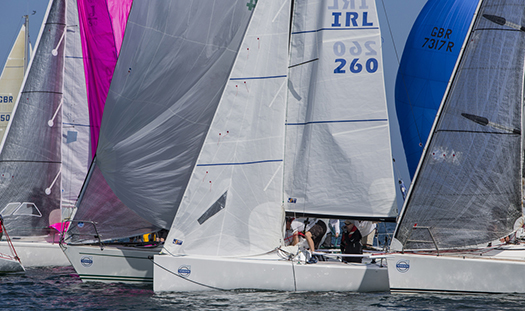
Everyone getting in everyone else's way, but that's part of the fun. The laid-back approach of the Volvo Dun Laoghaire Regatta as seen at 2013's event. Photo VDLR
For, in terms of boat size, the GP 14s will be among the smaller craft taking part in the VDLR, and they can find their own space. However, if you were campaigning a large cruiser-racer in one of the ten IRC classes which have to share the waters of Dublin Bay with 21 other boat classes during VDLR, would you expect to have your part of the event designated as the ICRA Nationals? On the contrary, if you were seriously concerned about the overall good of Irish sailing, you'd probably rightly think this was a spurious claim for what is essentially a fun event.
We were still mulling over the deeper meaning of Tim Goodbody's words in relation to Anthony O'Leary's opinions when this week another big beast in the sailing sphere, Minister for the Marine Simon Coveney no less, also launched into the choppy waters to be met with by those who would hope to rationalise the sailing programme into fewer but bigger international-standard events.
As he was speaking aboard the Naval Service's LE Eithne in Dublin's River Liffey at a reception to boost this summer's joint ICRA Nationals/Sovereigns event in Kinsale, it will be no surprise to learn that he was strongly in favour of it, so perhaps he reckons – unlike Anthony O'Leary - that Kinsale can cope with a substantial influx of visiting boats.
"Two events like this combined at the same time in one venue give extra strength" he said. "I want to see sailing in Ireland become much more ambitious in combining resources to create events which will have true international standing. This is a sport we should be really good at, both in participation and in staging events of world stature. Combining medium-sized events and regattas into one much bigger event like this one in Kinsale is going to be for the long-term good of Irish sailing in particular, and Ireland in general. The planned event is now expected to generate at least €800,000 extra income for the Kinsale area during the regatta period, while there's continuing beneficial spinoff for this harbour town which has added significance as the southern terminal and start point for the Wild Atlantic Way".

Norbert Reilly, Commodore of ICRA, with Minister for the Marine Simon Coveney at this week's reception aboard LE Eithne in Dublin to promote the combined ICRA Nats and Sovereigns Cup 2015 at Kinsale from 24th to 27th June. Photo: David Branigan
Doubtless we'll be getting spinoff of a different kind about these Ministerial views from the many people around the coast who work long and hard to keep alive those quirky little local regattas and special neighbourhood sailing and boating events which will never be major happenings of international stature, but are an essential part of the fabric of our many and varied maritime communities, and are deeply attractive for discerning visitor who shun crowds and seek out quiet enjoyment.
But as it is, aboard the Eithne we had yet another viewpoint to put into the cauldron of developing opinion, as the concluding speech was made by Nobby Reilly, current Commodore of ICRA. In a conversation with him before he made his speech, Nobby emphasised that the ICRA Nationals 2016 will be a stand-alone event once more, and he can be fairly certain about that, as the venue will be his own home port of Howth.
In the light of this, it should be remembered that in his blunt no-nonsense way, Nobby has done great work in encouraging newcomers into sailing. Earlier this week, I happened to be with some keen sailing folk from Wicklow including David Ryan – Farmer Ryan - whose remarkable Monster Project campaign of racing a Volvo 70 in Wicklow's Round Ireland Race 2014 had drawn on the efforts of Nobby Reilly and ICRA with their Let's Try Sailing campaign last May. This resulted in four wannabe sailors from remote parts of Ireland getting their first taste of the heavy metal with the Monster, and we'll see a film of it on RTE and other channels in due course, after the heroic task of cutting 147 hours of tape down to one hour has been completed.
But in the meantime, Nobby concluded the shipboard reception for this year's ICRA Nationals-with-the-Sovereigns-in-Kinsale with a spot of unexpected banter. "Maybe" says he, "maybe we should stop being concerned about trying to convince people that sailing is inexpensive. For we all know that, as it's a vehicle sport, there's bound to be basic expenditure over and above what you'd get with straightforward athletics and team sports. So maybe we should encourage people to get their kids to take up sailing on the grounds that if they come to like it, then there's no way they'll have the money to do drugs....."
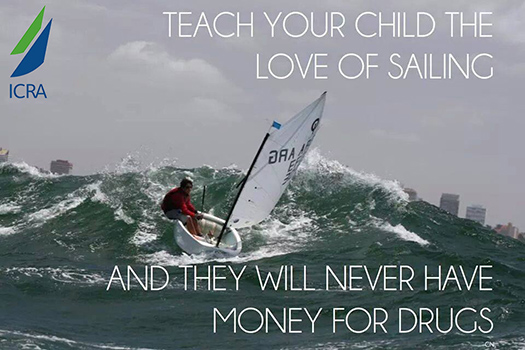
ICRA Commodore Nobby Reilly's positive response to the perceived costliness of sailing
Read also:
Should Irish Cruiser Racing (ICRA) Championships Stand Alone? (July 2013)
The Commodores' Cup – How Ireland Won It & Where It Might Go From Here (August 2014)
#vdlr – The "suburban sailfest" which is the biennial Volvo Dun Laoghaire Regatta this year (Thursday July 9th – Sunday 12th July) is marking its tenth anniversary with the sixth edition. It's a classic Irish mix of sailing sport at all levels aboard a wide variety of boats from many and often very distant places, combining to sail with the large home fleet in Dublin Bay in thirty different classes. And on each of the four days, colourful action afloat is followed ashore by a hectic pace of post-sailing celebrations in four waterfront clubs.
Three of these are venerable institutions with their origins in the midst of the 19th Century, and their homes in historic harbourside buildings each of which is, in its own way, an architectural masterpiece. And even the "newest" of the four waterfront clubs, the Dun Laoghaire Motor Yacht Club, is this year celebrating its Golden Jubilee.
The VDLR 2015 has much to live up to, but in the spirit of this youthful event in a mature setting, the people running it bring the necessary level of enthusiasm and expertise allied to unrivalled experience to maximize the enjoyment of a unique experience. W M Nixon casts an eye over something special.
"You have to remember that it's a regatta, not a championship. Enjoyment of sport comes first, and the purity of fierce competition second. But of course we're going to provide the best possible starts. And the intention is to have those starts leading into the best possible courses in the conditions prevailing."
"Yet the way we see it, people should be racing just as soon as possible after leaving the harbour. There's nothing which impairs simple sailing enjoyment so much as having to wait around in a perfectly good but maybe slightly fickle sailing breeze, hanging about in frustration while an overly-pernickety Race Officer dithers over setting the absolutely perfect start line".
If these were the words of some club's entertainment officer concerned with creating a good mood at some event no matter what happens in the racing, we'd treat them with some caution. But the speaker is not only a former and very actively sailing Commodore of two of Dun Laoghaire's most august yacht clubs, he's a helmsman/owner who has won championships to the top level in boats like the International Dragon and the International J/24.
He was also, in 1987, the lead helmsman on a 40-footer racing in the Irish Admiral's Cup team with such competence that he out-performed the legendary Lawrie Smith on a sister-ship during a tacking duel in the AC inshore events in the Solent, and then went on to be a lead helm when that boat won the Fastnet Race overall to conclude the series. More recently, he continues at the top level as one of the most successful owner-skippers in his Sigma 33 Offshore OD.
Welcome to the world of Tim Goodbody, sailing enthusiast extraordinaire, and the Chairman of the Organising Committee for Volvo Dun Laoghaire Regatta 2015. With all due respects to the three previous incumbents of this demanding post, he is the one with the most comprehensive record of personal sailing achievement in racing. So when he talks of "getting people out and racing just as soon as possible after leaving the harbour", we can be quite sure that the standards of start-line and course setting will be world class, as his stellar and continuing sailing career is allied to a formidable CV of involvement in sailing administration afloat and ashore.
Thus he was instrumental in devising the courses now used by Dublin Bay SC, and when Commodore of the Royal Alfred YC more than thirty years ago he led the way in developing the Superleague which set the standard as a season-long racing series at the time. Then as Commodore of the Royal Irish YC, he deftly combined the necessary roles of curator, committee man, accomplished owner-skipper and a public face of Dun Laoghaire sailing generally and one of Ireland's oldest and most distinguished clubs in particular.
With entries from 55 different clubs from all round the Irish Sea and further afield already in as the boats listed went through the 200 mark yesterday, a surge is expected ahead of the closing of the special early entry discount next Tuesday March 31st, and the VDLR 2015 administrative machine is fully in action to maximise an event which sees the old granite pond which is Dun Laoghaire Harbour embrace 21st century sailing.
It's pretty good going when you think that in two years time this totally artificial harbor will be shaping up to begin celebrating its Bicentenary, which can go on for as long as you wish, as the harbour was started in 1817, but it hadn't been sufficiently completed to stage a regatta until 1828.

The first regatta at Dun Laoghaire in 1828
Back then, some early yachtsmen staged match races between their often enormous yachts which tended to be based on the designs of the Revenue Cutters which were the fastest sailing vessels of their day. The prizes were appropriately enormous money purses of which a large proportion went to the sailors, so the professional crews raced with real aggression, and all sorts of devilish sabotage on the opposition was par for the course.
However, yacht racing was still in its infancy and while some owners were keen to do it, others – such as the Marquess of Anglesey who was one of the inspirers of this first event – were happier just to sail around displaying their extraordinary vessels to crowds which had never seen anything quite like it before.
The holding of more regular regattas in what was then Kingstown became part of the annual social season. Though the Royal Irish YC was the first club into being in 1831, it soon languished and it was the establishment of what eventually became the Royal St George in 1838 which made such annual regattas a key part of the annual high society season.
In other words, the events and personal displays ashore and along the waterfront were seen if anything as more important than the racing afloat. Then as now, the true sailing enthusiasts found this an annoying state of affairs, so they took to devising ways of making the sailing more important, rather than just a background to the various dramas and entertainments taking place ashore.
Doubtless the idea had been tried earlier, but in 1860 there was certainly an attempt at an early regatta week. By this time the Royal St George clubhouse had greatly expanded, and the Royal Irish was re-invigorated in its relatively-new1851-built clubhouse. Several days of racing were held with the local large-yacht flotilla enhanced by craft from the south coast. And then, as many of the vessels were headed back to Cork Harbour afterwards, the Admiral of the Royal Cork, Thomas G French, suggested an offshore race between Dublin Bay and Cork Harbour which duly took place, one of the world's very first genuine passage races.
In all, 15 yachts took part, but not all did so with the same urgency. Seven went away promptly as though it was really a race, but the remaining eight crossed the start line at different times within the next hour.
Ironically, the finish times two days later came down to a matter of minutes. The 90-ton schooner Kingfisher was first into Cork Harbour but a beat to the Royal Cork YC finish line at Cobh against the ebb was not at all to her liking, and the 80-ton cutter Peri took the lead. But then in tricky conditions in the harbour the even smaller 39-ton cutter Sybil managed to take the lead under the command of amateur skipper Henry O'Bryen, and hung onto to it to scrape across three minutes ahead of Peri with Kingfisher two minutes later.
Thus all the excitement and interest focused on the in-harbour stages. Back in Dublin Bay, this was proving the case with the new harbour, with one of the stars of Kingstown sailing drama at this period being Belfast linen magnate John Mulholland's legendary 1865-built schooner Egeria, which made a speciality of sweeping up to the finish lines right in close off the clubs with all sails set.
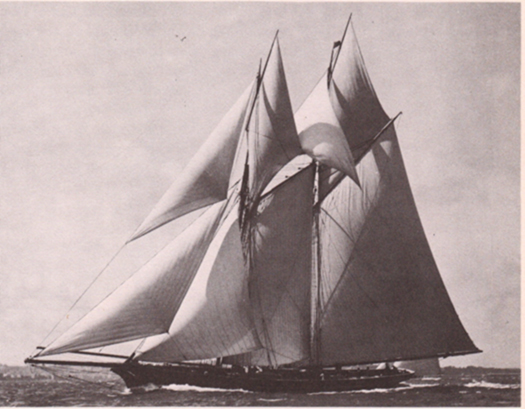
The successful 1865-built schooner Egeria, owned by John Mulholland from Belfast, was renowned for racing right up to the waterfront in Dun Laoghaire with all sail set
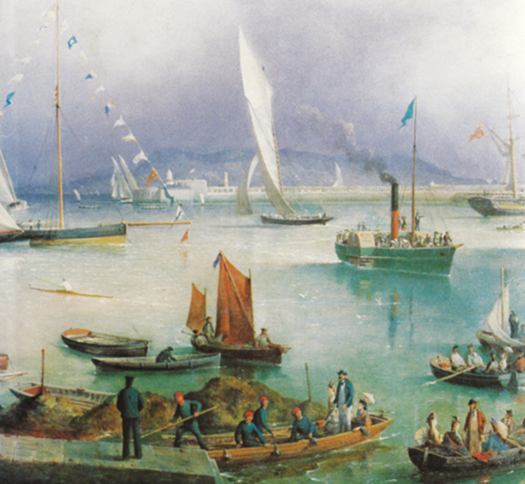
Classic Dun Laoghaire regatta scene by Richard Bridges Beechey. Courtesy RStGYC
The marine artist Richard Breeches Beechey made a speciality of recording these Dublin Bay dramas, and the enthusiastic owners were there to act their roles, no more so than John Jameson of the eponymous whiskey firm, whose successful cutter Irex was a star contender at major regattas all round the coasts of Britain and Ireland. When Irex was back in Dublin Bay, the crowds gathered, for in those days of much more limited entertainment, big boat racing was a must-see spectacle.
Yet at the same time there was something of a revolution going on in sailing, with the racing sport being codified in a movement largely led by the Royal Alfred YC, while small boat racing came centre stage when the Dublin Bay SC was established in 1884, with the one design concept making its appearance with the 13ft Water Wags in 1887.
This was all well and good for the underlying health of sailing. But for traditional yacht clubs with impressive premises which were ultimately there for the great and good to get involved with high end yachting at the height of the summer season, it was a mixed blessing, as each club's annual regatta tried to be all things to all sailing men and the few sailing women, while at the same time keeping the pavilion members happy.

In an age of less sophisticated entertainment, robust waterfront sports were an integral part of the Edwardian era regatta at the Royal St George YC. Photo courtesy Theo Harris
With yacht sizes decreasing, the spectacle and style which under-pinned a classic regatta were increasingly lacking, and while each club's stand-alone annual regatta continued as the centrepiece of its summer programme until well into the late 20th century, the increasing length and variety of the sailing season, and the easy accessibility of other sailing events for specific classes, meant that the traditional Dun Laoghaire regatta was becoming a threatened species.
So in the late 1940s when the newly-formed Irish Dinghy Racing Association was finding success with its annual Dinghy Week at popular sailing venues all round the coast, inevitably there began to be talk of a Regatta Week among the clubs in Dun Laoghaire, with the inevitable comparison to the success of Cowes Week being used to encourage the idea.
You will still hear the comparison to Cowes made from time to time, so let's get something off our chest. There is simply nowhere quite like Cowes. It's on an island, at the epicentre of a very interesting stretch of sailing water. And relatively few people live there. So when the annual Cowes Week is staged, almost every participant is a visitor. To a great extent, this is what makes it special.

The VDLR is ideal for a spot of family racing in all classes including the venerable Water Wags, but this serene mother and daughter crew combination aboard the family Wag is just ever so slightly different. Both are Olympic sailors. That's Cathy McAleavey (470 in 1988) on the spinnaker trim, and her daughter Annalise Murphy (Laser radial in 2012) is on the helm. Photo: VDLR
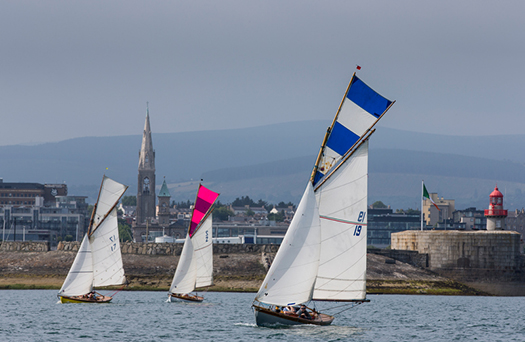
The Howth 17s – established 1898 – make the biennial pilgrimage across Dublin Bay to race in VDLR. Photo: VDLR
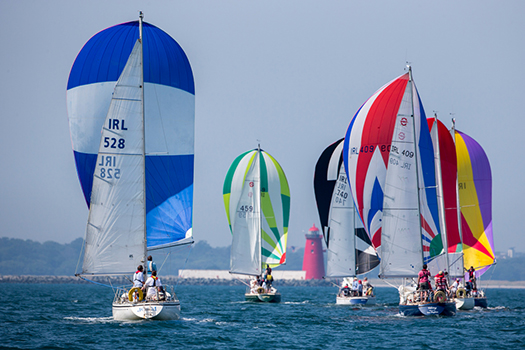
The Shipman 28s may be seen as handy little cruisers at other sailing entres, but in Dun Laoghaire they race as a one design class. Photo VDLR
But at many other sailing places in general, and in Dun Laoghaire in particular, you're right at the heart of a large and affluent resident population. The underlying atmosphere is inherently different, and any successful Dublin Bay event with a regatta flavour has to bear this quietly in mind if it's going to be a success.
Be that as it may, by the mid-1950s a Dun Laoghaire Regatta Week had been rather tentatively introduced, but the Irish economy was so depressed throughout that dismal decade that it was never a runaway success, and without any specifically Irish sailing media to record it, we know virtually nothing of what happened, and in any case it didn't last.
Yet boat numbers were increasing, so for a while the traditional annual Club Regatta had something of a heyday with the perfect balance between fleets afloat and the lack of too many distractions by other sports and interests ashore. For a brave new era, the annual regatta with the clubhouses bedecked in bunting was quite the thing.
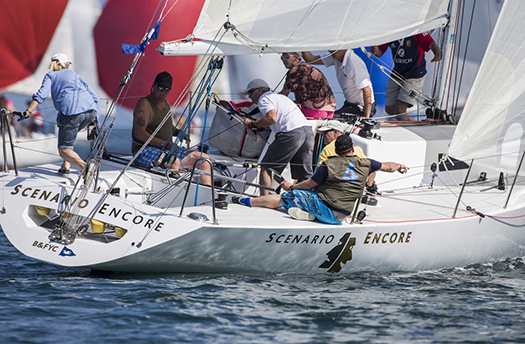
You don't absolutely have to go to Lancashire if you want to recruit a tattooed crew, but it helps. This is Scenario Encore from Blackpool & Fleetwood YC at VDLR 2013. Photo: VDLR

Ever get the feeling that everybody wants to be in the same place at once.......? Photo: VDLR
However, sailing was developing, and there came a new emphasis in the 1970s on offshore racing This in turn led to events like ISORA Week which could be tailored to match the established regatta programme. But then life patterns changed again, offshore racing was seen as almost anti-social, and club officers cast around for a re-shaping of the programme which would provide a compact event which had contemporary appeal for busy people who had many other interests to attend to and obligations to fulfill.
It was three or four years after the turn of the Millennium that the four Dun Laoghaire clubs tasked a working party of their junior flag officers with devising a regatta format which would suit the needs of the 21st Century. Somewhere out there, there has to be an individual original thinker who first proposed the key concept of a four day event evenly spread across all the clubs. We salute him or her, whomsoever they may be. But it went through so many modifications and mutations that the Dun Laoghaire Regatta, as it was first launched some time in late 2004 with the first one scheduled for 2005, had become a completely novel fixture, something carefully tailored to Dun Laoghaire as it has become today, taking into account the way of life of the people who sail from this great and unique port, and the expectations of the people who come to sail with them at their biennial suburban sailfest.
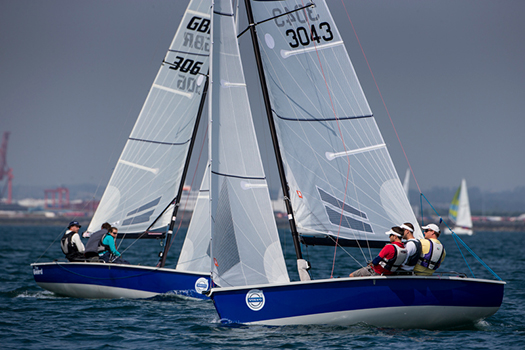
Perfect racing for the SB20s at VDLR 2013. Photo: VDLR
Even in its earliest forms it was such a novel concept that it clearly required someone very special to head up its nascent organising committee, but that was soon put on the right track with Brian Craig of the Royal St George YC put in charge as Chairman. Craig – the quintessential can-do backroom boy who so doggedly remains a behind-the-scenes figure – realised that careful diplomacy was needed if his new committee was going to avoid treading on established toes in the four existing club administration structures.
So he advertised for an administrative secretary with significant experience in office organisation and sailing, yet without any direct personal links to any of the Dun Laoghaire clubs. You'd have though this an almost impossible order with its very specific and unusual job-spec requirements, but they filled the bill precisely with Ciara Dowling. She'd grown up in the Irish countryside with no connection to boats or sailing, yet on any visit to Dun Laoghaire she'd felt drawn to the sport. However, it was while working in London as an office manager in her mid-twenties that she got involved afloat through a corporate outing for a rough day's sailing in the Solent, and was soon hooked while everyone else was sea-sick.
Working in sailing of any kind became her ambition, but it didn't always work out smoothly, yet she managed to put in a formidable amount of sea time and during a period back in Ireland she got signed up for one of the Irish crews (skippered by Tom McWilliam) in the Teachers Round Britain Challenge. By this stage she was finding sailing berths in Dublin Bay while moving between Ireland and London wherever there was boat-related work to be found, but at the time the notice for the Dun Laoghaire Regatta secretary was posted she was living in Howth and had become a member of Howth YC, but was not a member of any Dun Laoghaire club. That seemingly impossible job-spec outline had been hit on target.

Ciara Dowling with her gentlemen friends. The VDLR Secretary with the Chairmen who are (left to right) Tim Goodbody (2015), Adam Winkelmann (2011-2013), Phil Smith (2009), and Brian Craig (2005-2007).
Running what is now the Volvo Dun Laoghaire Regatta is not a full-time job, but as it rolls on through its biennial reincarnations, Ciara Dowling's unrivalled experience of the VDLR in particular and event management in general gives Dun Laoghaire sailing a very smooth management team for an event which can be constantly modified to suit changing tastes, while also competently dealing with a rush of last-minute entries if a good weather forecast comes along, as happened in 2013.
With the discount deadline looming next Tuesday, we'll leave fuller consideration of the fleet for a future date, but be sure that there are plenty of hot boats already in, boats of the calibre of Conor Phelan's Ker 36 Jump Juice from Cork which was pace-setting in Dublin Bay at the ICRA Nationals last year, and also already in the listings in what promises to be a very hot J/109 championship is Liam Shanahan's Ruth from the National, ISORA hotshot and oh-so-nearly winner of last year's Round Ireland.

The VDLR is one of the biggest annual gatherings for the historic IDRA 14 class. Photo: VDLR
And though the mood of the regatta is such that the organisers are very wary of declaring an overall winner, the feeling on the waterfront was that 2013's had been Nigel Biggs' classic Humphreys Half Tonner Checkmate, which has of course recently been sold to Dave Cullen of Howth and is a certain contender this summer.
It takes a while to get your head round the notion of 30 classes (or maybe now it's 31 with the RS Elites throwing their hats into the ring yesterday), and they'll be racing in six different areas under the direction of Race Officers of the quality of Jack Roy and Harry Gallagher.
In all, there are 150 volunteers involved, with a veritable fleet of support RIBs, so every day what mounts to a small navy is going to set out to go to sea to provide what is hoped will be some very special sport.
Tim Goodbody has only been in the chairman's job since the end of last summer, which he feels gives little enough time - he would recommend that any successor gets his feet under the table immediately after the St Patrick's Day holiday in the previous year. In other words, he reckons an absolute minimum of 15 months is required to maximize the success of this unique event.
But as he gets to grips with it, he is effusive in his praise for the support of the Dun Laoghaire Harbour Company, while the continued backing of Volvo through their people at Spirit Motors has kept the show on the road. The regatta's founding in 2005 saw it come into being just as the economy was starting to overheat, yet Volvo came aboard in 2007 and has stayed on as a great pillar of support.
But in the end, the success of it all will come down to you - the competitors. Let us hope that what we've outlined as the long and varied story of regattas in Dun Laoghaire will add to the richness of your experience, and the deeper meaning of an event of this type being held in Dublin Bay. It's no exaggeration to assert that racing in VDLR 2015, no matter what boat you may be sailing, is sailing the dream while being an active part of living history with a future dimension.
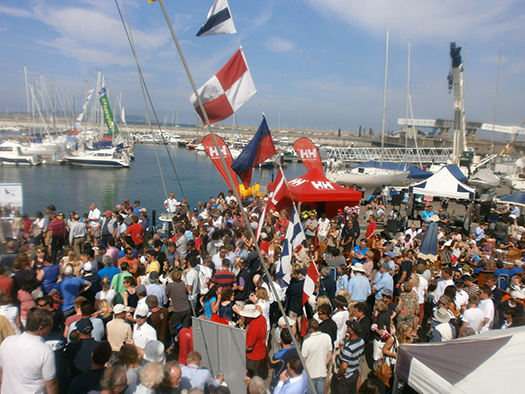
It has been described as "Leopardstown-on-Sea", but it's much better than that......Photo: VDLR
The 2015 Volvo Dun Laoghaire Regatta Programme (with a full entry list) will be published in late June as a supplement to Summer Afloat magazine
Will Portsmouth Yardstick Dinghy Class Be Reinstated at Volvo Dun Laoghaire Regatta?
#dlregatta –The race is on to muster a viable handicap dinghy class after Volvo Dun Laoghaire Regatta dropped its Portsmouth Yardstick (PY) dinghy class start from July's biennial event on Dublin Bay.
The organisers say they are limited by resources and personnel but hold out hope that the class could be reinstated if they 'receive written entries from eight compatible dinghies (on block) to the regatta secretary'.
Mixed dinghy sailors argue the decision to drop the class for the 2015 is 'a most disappointing outcome'.
Ireland's biggest regatta is expected to have over 500 entries this year.
Organisers say that 'due to a request from the Laser Standard Rigs to have their own start, the low number of other PY entries during previous regattas, and the large number of other classes to be catered for, it has been decided not to give a PY start in 2015.
'It does seem an odd decision, particularly in a context where sailing is trying to be more inclusive and trying to get people into the sport. Mixed Dinghies is a great way of doing this' PY sailor Hugh Sheehy told Afloat.ie.
Among others, the 'Sailing In Dublin Club' has backed up Sheehy's plea for reinstatement: 'As our members are regular entrants to the Dun Laoghaire Regatta, we would like the PY start to be reinstated. Why not be as inclusive as possible to encourage dinghy sailing in Dun Laoghaire?'
































































